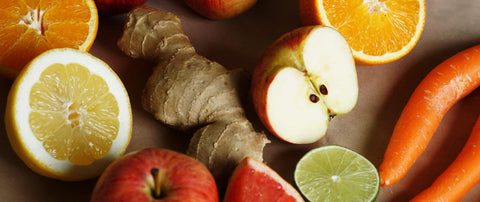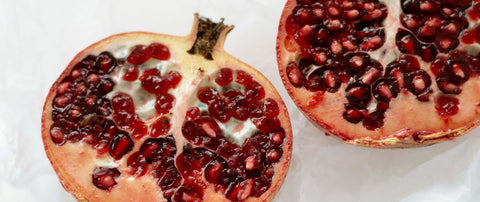Superfoods - a term that we now associate with a healthy lifestyle, numerous nutrients and a variety of health benefits. But what can chia seeds, avocados, goji berries and the like really do and what makes them ‘better’ than conventional fruit and vegetables? We would like to address these questions in this blog post. We'll show you what makes superfoods so special and whether they're really worth the hype.
Inhaltsverzeichnis
What are superfoods?
Nowadays, we can no longer avoid superfoods such as chia and linseed, goji berries, chlorella, spirulina and many more. Whether in the supermarket, organic shops, restaurants or on social media - they are now on offer everywhere. They promise us an extra portion of important nutrients and stand for more energy and well-being in everyday life. But what are superfoods actually? The word ‘superfoods’ is made up of ‘super’ and ‘foods’, which initially suggests that they are not just common healthy foods, but special types of fruit and vegetables, as well as fruits, spices and seeds that are not only delicious, but can also have numerous positive effects on the body. A few of these positive effects are, for example, an improvement in the immune system and intact digestion. There is no official definition for superfoods. In marketing terms, they are simply called that because they are said to have an increased micronutrient content. This means more vitamins, minerals and secondary plant substances. Superfoods enjoy great popularity worldwide, but also in this country. It is no coincidence that a survey conducted in 2017 found that almost 47% of the German population consumes superfoods.1
The hype surrounding superfoods
Superfoods have always existed and were not simply ‘invented’. Spices such as turmeric and ginger have been used in traditional cooking and medicine for centuries. This aspect shows that social media and marketing concepts in particular play a major role in the popularity of superfoods. By mentioning superfoods in social networks, society is characterised and influenced in this way. As a result, superfoods are constantly gaining a firm place in society. Influencers, nutrition experts and the beauty and fitness industry in particular are capitalising on these trends and putting them front and centre. This increases demand and consumption in our society. Long-forgotten superfoods are gradually reappearing on the market. This is creating the superfood hype.
From a health perspective, superfoods are said to strengthen the immune system, have an antioxidant effect, support weight management, improve digestion, promote skin health and increase energy levels as part of a holistically healthy diet.
Studies on superfoods
There are actually some studies that recommend integrating superfoods into your diet. For example, one study investigated how certain superfoods can help type 2 diabetes patients to keep their blood sugar stable. The researchers found that foods with polyphenols (e.g. berries), fermented dairy products (such as yoghurt), wholegrain products, nuts and proteins in particular have a positive effect on blood sugar. It was particularly noticeable that fermented yoghurt with vitamin D or probiotics had a lowering effect on the average blood sugar level. Blood sugar was reduced by around 1%.2
Another study tested superfood seeds (flaxseeds, chia seeds, hulled sunflower seeds and two types of processed hemp seeds) for potential health benefits. This included how well these seeds affect cell survival. It was found that a larger amount of flaxseed, chia seeds and sunflower seeds can increase cell viability. Sunflower seeds were significantly more antioxidant than the other seeds.3
There are other studies on individual foods known as superfoods that report positive health effects. With this in mind, we have compiled a few popular superfoods and their benefits, including existing studies:
Goji berries:
These berries are mainly native to Asia, particularly the north-western part of China. Goji berries are used to make tinctures and juices, among other things, as they are rich in antioxidants and can alleviate oxidative stress. Other benefits of goji berries include anti-ageing effects, immune system support, antioxidant boosting and even cancer-preventing properties.4
Açaí berries:
The acai palm has been kept as a crop in Central and South America for very many years. This is because it is said to have many positive properties. Both in vitro and in vivo studies show that acai berries have antioxidant and anti-inflammatory effects, among other things. In addition, the berries promote the cardiovascular system, the digestive tract, the nervous system, the regulation of blood sugar and inhibit the growth of malignant tumours. Furthermore, clinical studies have found that açaí can protect against vascular anomalies and metabolic stress caused by physical exertion. For this reason, açaí is often used in the food and cosmetics industry. 5
Avocado:
Avocado is one of the superfoods par excellence. It is a very popular berry in many countries - as it is here. The avocado contains important phytochemicals and many nutrients - including fibre, potassium, sodium, magnesium, vitamins A, C, E, K1, B3, B6, B9, B5 and B2. Numerous medical studies suggest that avocados support cardiovascular health. One of these studies states that avocados can support weight management.6
Chia seeds:
Chia seeds are known for their swelling properties and are primarily consumed for weight loss. They are rich in fibre, minerals, omega-3 fatty acids and vitamin A and B complexes. Chia seeds have the ability to support chronic diseases such as diabetes, obesity and cardiovascular diseases. 7
Linseed:
Like chia seeds, linseeds also have a high swelling capacity. They are also very healthy and contain numerous nutrients. This is proven by the following study: Young adults were asked to consume 50 g of linseed daily over a period of four weeks. The result was that the content of alpha-linolenic acid in the fatty tissue and the proportion of omega-3 fatty acids increased. The so-called ‘bad cholesterol’, on the other hand, decreased. 8
Walnuts:
Walnuts are the perfect snack between meals. Not only are they tasty, they also have numerous health benefits. Researchers found this out by analysing the blossom, shell and kernel of the walnut. They found that eating walnuts can help prevent cardiovascular disease, intestinal dysbiosis, neurodegenerative diseases and even cancer. 9
Curcumin:
Curcumin is the main component of the turmeric root. Several studies have shown that turmeric has many health-promoting properties. Among other things, it has anti-inflammatory, antioxidant, antidiabetic, antiviral and antibacterial effects. In addition, further tests show that a higher amount of curcumin is well tolerated. 10
Artichokes:
Artichokes have hardly any calories and therefore offer a good way to regulate weight. They also contain bitter substances that stimulate the metabolism and the feeling of satiety. They have an antioxidant and bile-promoting effect. The latter simplifies the digestion of fats. Artichokes contain vitamins A, K and B complexes, among others, and should therefore be part of a balanced diet.
Broccoli:
Broccoli is also a very popular superfood that should not be missing from a healthy diet. It contains lots of vitamins and minerals as well as protein and fibre. The low-calorie super vegetable also has an antioxidant and anti-inflammatory effect and can support cholesterol levels.
Anzeige

Spirulina:
Spirulina is a type of algae that is known for its high nutrient content. And rightly so, as it is rich in proteins, vitamins, minerals and essential fatty acids. The high content of vitamin B12 in particular, as well as beta-carotene, iron, calcium and phosphorus, make this algae a real power food. Spirulina can prevent oxidative stress and help with obesity, cardiovascular disease, diabetes and overweight. 11 Spirulina is usually taken as a dietary supplement.
Chlorella:
Unlike spirulina, chlorella is a single-celled type of algae, but it also boasts a considerable amount of nutrients. It contains proteins, vitamins, minerals, antioxidants and omega-3 and 6 fatty acids. Clinical studies show that chlorella can help with high cholesterol and blood sugar levels as well as oxidative stress and cancer. 12
You can find out more about spirulina and chlorella in this blog post: Chlorella vs. spirulina - The differences and benefits of the two microalgae
Advantages of superfoods
A big advantage of superfoods is that there is a huge selection, so there is something for every taste. If you like it sweeter, mangoes, dates or pomegranates could be an option for you. But slightly hot and spicy superfoods such as ginger or turmeric are also very popular, especially for colds. This is because ginger and turmeric can have a supportive effect on the immune system. However, there are also some superfoods such as quinoa and chia seeds, which are excellent sources of energy. Quinoa is a grain that provides lots of nutrients, fibre and protein. Chia seeds are also rich in omega-3 fatty acids. This makes them extremely energising. Superfoods such as lentils can also help with weight loss. Due to their high fibre content, they have a filling effect and can keep blood sugar levels stable. The beauty industry has also recognised the value of superfoods and offers numerous face and body care products containing superfood extracts. For example, you can find various oils and creams that are enriched with ingredients such as berries, pomegranate, green tea, etc. These often contain vitamin C, which has an antioxidant effect. These often contain vitamin C, which has an antioxidant and anti-inflammatory effect.

Domestic vs. exotic superfoods
The large selection of superfoods offers both local and exotic alternatives. The preferred flavour often plays an important role in the selection. What you ultimately choose is up to you.Advantages of local superfoods:
Domestic superfoods such as berries, linseed and kale are available regionally and seasonally. So you can be sure that they can be found in many local supermarkets or organic shops. Local superfoods travel much shorter transport routes, so they are fresh and nutrient-rich. Harvesting local superfoods is much more environmentally friendly overall, as no costly transport is required. Domestic superfoods are therefore also cheaper than exotic ones. Buying local superfoods also supports the local economy. An important point is that it is easier to keep an eye on pesticide contamination with regional superfoods.
Advantages of exotic superfoods:
Exotic superfoods contain nutrients that are not found in our domestic superfoods. In particular, chai seeds, goji and acai berries are considered very healthy as they have a unique profile of vitamins, minerals and antioxidants that are not commonly found in our regional diet. They also offer an exciting opportunity to enjoy different foods in everyday life that differ in flavour and appearance from our food. Exotic superfoods are particularly popular in Western countries.
How can you enjoy superfoods?
Trends often set the first step here too. Bowls, smoothies and healthy shakes are the hype par excellence. And not without reason: they offer the perfect opportunity to combine several superfoods in one meal and are also extremely tasty. For example, chia seeds can transform a boring plain yoghurt into an energy-boosting chia seed pudding. Different types of berries can be used as toppings for bowls, providing an additional source of nutrients. Matcha has also made a name for itself as a superfood by offering a good alternative to coffee. It generally contains less caffeine than coffee and has the advantage that the energy supply does not rise and fall again in the short term, but rather runs evenly. Last but not least, golden milk, of which turmeric is a main ingredient, is also a major trend. This also combines several sources of nutrients. Another way of consuming superfoods is by taking nutritional supplements. Whether individual superfoods or several combined with each other - the choice here is also very large.
Conclusion:
The hype surrounding superfoods is definitely more than just marketing. The comprehensive and positive studies on various superfoods confirm that these foods definitely bring improvements in various health areas. It is therefore worth integrating many superfoods into your diet. The more the better! They offer an ideal supplement to your daily diet. Nevertheless, a balanced and varied diet is the best way to get enough nutrients to promote good health. Many superfoods are also available as dietary supplements, which can also be a great option for integrating more superfoods into your everyday life. Overall, it's safe to say that superfoods are definitely worth the hype!
Sources:
-
Statista. (2017). Verzehrhäufigkeit von Superfoods in Deutschland. https://de.statista.com/statistik/daten/studie/721655/umfrage/verzehrhaeufigkeit-superfoods-lebensmittel/
- Pires C. Superfoods for Type 2 Diabetes: A Narrative Review and Proposal for New International Recommendations. Medicina (Kaunas). 2023 Jun 21;59(7):1184. doi: 10.3390/medicina59071184. PMID: 37511996; PMCID: PMC10384771.
- Barsby JP, Cowley JM, Leemaqz SY, Grieger JA, McKeating DR, Perkins AV, Bastian SEP, Burton RA, Bianco-Miotto T. Nutritional properties of selected superfood extracts and their potential health benefits. PeerJ. 2021 Nov 26;9:e12525. doi: 10.7717/peerj.12525. PMID: 34900436; PMCID: PMC8628624.
- Ma ZF, Zhang H, Teh SS, Wang CW, Zhang Y, Hayford F, Wang L, Ma T, Dong Z, Zhang Y, Zhu Y. Goji Berries as a Potential Natural Antioxidant Medicine: An Insight into Their Molecular Mechanisms of Action. Oxid Med Cell Longev. 2019 Jan 9;2019:2437397. doi: 10.1155/2019/2437397. PMID: 30728882; PMCID: PMC6343173.
-
Laurindo LF, Barbalho SM, Araújo AC, Guiguer EL, Mondal A, Bachtel G, Bishayee A. Açaí (Euterpe oleracea Mart.) in Health and Disease: A Critical Review. Nutrients. 2023 Feb 16;15(4):989. doi: 10.3390/nu15040989. PMID: 36839349; PMCID: PMC9965320.
- Dreher ML, Davenport AJ. Hass avocado composition and potential health effects. Crit Rev Food Sci Nutr. 2013;53(7):738-50. doi: 10.1080/10408398.2011.556759. PMID: 23638933; PMCID: PMC3664913.
- Agarwal A, Rizwana, Tripathi AD, Kumar T, Sharma KP, Patel SKS. Nutritional and Functional New Perspectives and Potential Health Benefits of Quinoa and Chia Seeds. Antioxidants (Basel). 2023 Jul 12;12(7):1413. doi: 10.3390/antiox12071413. PMID: 37507952; PMCID: PMC10376479.
- Cunnane SC, Hamadeh MJ, Liede AC, Thompson LU, Wolever TM, Jenkins DJ. Nutritional attributes of traditional flaxseed in healthy young adults. Am J Clin Nutr. 1995 Jan;61(1):62-8. doi: 10.1093/ajcn/61.1.62. PMID: 7825540.
- Ni ZJ, Zhang YG, Chen SX, Thakur K, Wang S, Zhang JG, Shang YF, Wei ZJ. Exploration of walnut components and their association with health effects. Crit Rev Food Sci Nutr. 2022;62(19):5113-5129. doi: 10.1080/10408398.2021.1881439. Epub 2021 Feb 11. PMID: 33567903.
- Abd El-Hack ME, El-Saadony MT, Swelum AA, Arif M, Abo Ghanima MM, Shukry M, Noreldin A, Taha AE, El-Tarabily KA. Curcumin, the active substance of turmeric: its effects on health and ways to improve its bioavailability. J Sci Food Agric. 2021 Nov;101(14):5747-5762. doi: 10.1002/jsfa.11372. Epub 2021 Jul 14. PMID: 34143894.
- Gogna S, Kaur J, Sharma K, Prasad R, Singh J, Bhadariya V, Kumar P, Jarial S. Spirulina- An Edible Cyanobacterium with Potential Therapeutic Health Benefits and Toxicological Consequences. J Am Nutr Assoc. 2023 Aug;42(6):559-572. doi: 10.1080/27697061.2022.2103852. Epub 2022 Aug 2. PMID: 35916491.
- Panahi Y, Darvishi B, Jowzi N, Beiraghdar F, Sahebkar A. Chlorella vulgaris: A Multifunctional Dietary Supplement with Diverse Medicinal Properties. Curr Pharm Des. 2016;22(2):164-73. doi: 10.2174/1381612822666151112145226. PMID: 26561078.




 DE-ÖKO-006
DE-ÖKO-006
